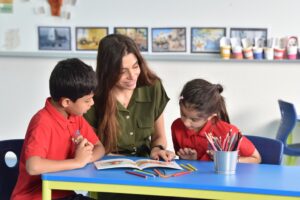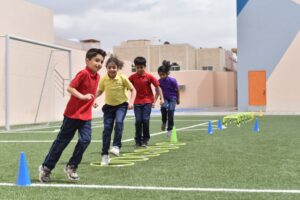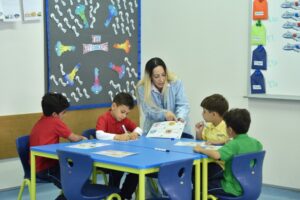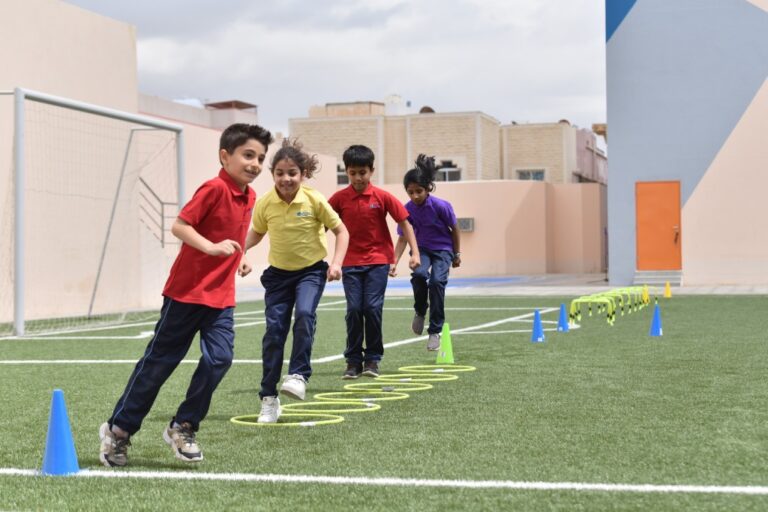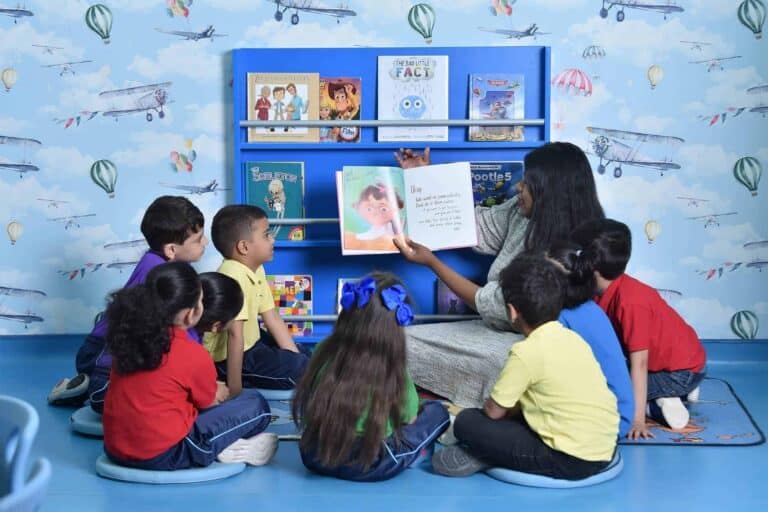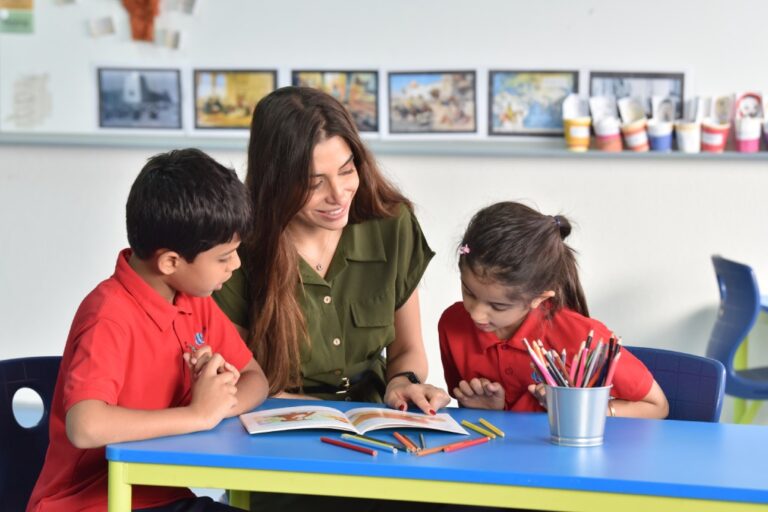Bill Gates and Paul Allen, the founders of Microsoft, met in middle school at a collaborative Computer Club class on basic programming. Together, the two changed the future of computing and the world at large.
For us educators, instances like these only serve to reinforce our belief in collaborative learning, and the impact it has on the lives of not just our learners but teachers as well.
What is Collaborative Learning?
Let’s begin with understanding collaborative learning. It is a broad term that covers a variety of approaches to learning. At OWIS, learners work in groups, collectively searching for greater understanding and solutions, attaining higher levels of thinking and self-realization.
If you want to see how this approach to learning (and teaching) works in favor of every learner at OWIS, read ahead.
Benefits of Collaborative Learning for Students
Learning is meaningful only when the process is attuned to each learner’s needs, strengths, and goals. To better serve our learners, the teaching approach at One World International School in Riyadh is not teacher-centric but in fact: student-centric. Here are some benefits it brings:
Improves Cooperation
Learning together in groups helps our learners engage through discussions with each other. This enables them to manage and carry out the specific tasks assigned with ease and peer support. In addition, engaging in thoughtful discussions with their mates helps increase their appreciation of each other and instills a deeper sense of camaraderie.
Promotes Learning From the Viewpoint of Others
A major benefit of collaborative learning for students is that learners get to hear and understand several viewpoints. It exposes them to diverse ideas, thoughts, and explanations.
According to studies, when learners can access diverse viewpoints from people of different backgrounds, it expands their understanding, and they learn so much more.
Improves Active Listening and Public Speaking
Understandably, a lot of learners can find it hard when it comes to public speaking. However, with the help of collaborative learning strategies, their social discomfort can be assuaged and replaced with a sense of social ease.
Through regular group discussions, students at OWIS gain the confidence to speak in front of an audience. Furthermore, they also learn to listen actively, challenge other people’s ideas and build a collective framework with others.
Promotes Listening to Advice and Criticism
Collaborative learning in our safe and open classroom settings helps learners improve their listening capabilities by letting them freely express and talk about their ideas. We encourage them to offer arguments for or against their peers’ arguments.
This helps students better understand the topic of discussion as they have different angles to arguments and variegated explanations to factor in and appreciate.
Makes Learning Active
Instead of just taking in information and moving on, learners organize their thoughts, develop cohesive arguments to demonstrate their point, defend their views in front of their peers, and then try to convince them in favor of their arguments.
This form of active engagement ensures students are learning to disseminate, obtaining more knowledge to understand, and retaining that knowledge by simply being involved proactively.
Collaborative Learning Strategies For Teachers
Here are some ways teachers at OWIS incorporate collaborative learning in classrooms;
Creating Flexible Group Norms
Interactions between students and their teachers influence collaborative classroom learning. Negotiation and interactivity are crucial. Teachers can try developing a new norm using outside information or rotating the group members.
Always set rules for group interactions, especially for younger students. For the older students, allow them to set their own rules and norms as the teacher monitors.
Use the Pre-test, Post-test Strategy
Pre- and post-test are collaborative learning approaches that determine if the groups are learning. Giving the groups assignments gives them a goal to work towards and makes learning a priority.
Moreover, it’s an effective way to gauge the effectiveness of the group in classroom learning. If the teacher notices any differences in the assessments, they can make changes over time.
Create Clear Group Goals
Effective collaborative learning strategies require teachers to set group goals and individual accountability. Therefore, defining the lesson’s objectives and goals is crucial before beginning any assignment. This saves time and keeps the group alert and on task.
Promote Open Communication and Build Group Trust
Trust is crucial for the success of any group work. Therefore, it’s crucial for the teacher to deal with any emotional problems as soon as they arise, as with any interpersonal problems. Interpersonal communication enables the students to explain things better to their peers.
Furthermore, students who receive better explanations gain more from collaborative learning. Therefore, focus on open communication.
Create Group Roles for the Tasks
Whatever the task for the group is, breaking it into parts helps save time and improves accountability. Teachers give different students different roles in the groups. Alternatively, the teacher can let the students choose their roles and alternate after some time or according to classes or assignments. For instance, the science group recorder can become the math group leader.
Also Read – Importance of Learning Skills in 21st Century
Examples of collaborative learning activities
Collaborative learning can be achieved through several channels within the International school or classroom. But the main aim is to expand each learner’s conceptualization of ideas and improve their long-term retention.
At OWIS Riyadh, these activities aren’t just restricted to young learners alone, but also to the faculty. Here are some examples of collaborative learning activities we use;
-
Problem-Solving Across Teams
Involves bringing different groups together and presenting them with the same problem. Before they commence, teachers present an outline of how they would like the results to be and let them work on it. In the end, learners justify each team’s findings and outline their plans for accomplishing the task.
-
Building a Collaborative Learning Community
A collaborative learning environment helps foster problem-solving and teamwork, and prioritizes open communication. This, in turn, gives learners a chance to teach and learn from each other. This has helped build a community for students and teachers to collaborate and participate in learning actively.
-
Developing New Techniques
At OWIS, collaborative learning has helped us develop new techniques that improve both our teaching and learning programs. For example, teachers work in teams and groups to identify new and relevant concepts, after which they devise new teaching techniques that will engage learners.
The teachers then present their findings through a question-and-answer session with their peers. This helps attune the techniques further, making them better suited for learning and teaching.
Conclusion
Learning is better when it’s social, inclusive, and open. Teachers at OWIS Riyadh leverage different media and methods like technology, groups discussions and projects to inculcate new ideas and instill lifelong curiosity in each learner.
Collaborative learning has enabled our students to share perspectives with their peers, and teachers with their colleagues. From classroom group collaborations to the latest online technology, inquiry based learning at OWIS helps learners and teachers develop innovative solutions that make better learning and teaching possible: each day!

Ms. Dominika Kawalek
-
Ms. Dominika Kawalek#molongui-disabled-link





